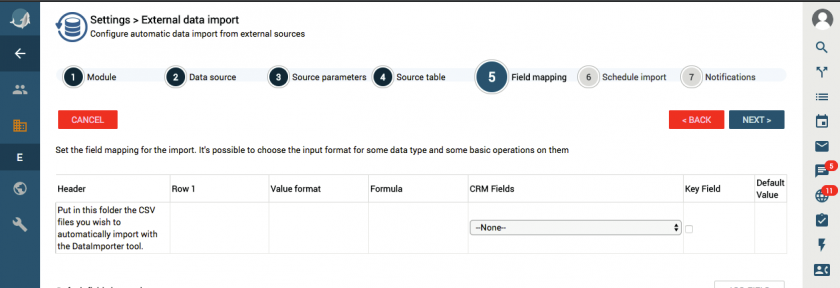17.16 Data Import
This tool makes it possible to import data in vte (if the installation is on-site) from an external source, which can be both CSV (as already occurs through the standard import of master data) and database types.
You can schedule the process according to a certain time frequency and enter advanced queries for data extraction. Let's take a step-by-step look at the import procedure, using a database import case as an example. To configure a new import, press Add.
N.B.: For the import of modules that also have products within them (e.g. Sales Orders or Quotes), the procedure is different.
You need 3 different CSV files to import in the order described:
- A file containing the products inside the block with only the basic data.
- A file for the 'header' of the module containing the product block where only the data related to it will be inserted.
- A file containing essential data for the product block where you will need two identification fields to link the 'header' and the 'products' previously imported; in addition to these you will need, as mandatory, the fields: Product Name, Quantity and List Price.
IMPORTANT: In the corresponding modules of the first two files, a field must be created to be used for the connection between the two in the product block e.g. - external ID
After importing the first two files, remember to map the external ID as an identifier field; with the procedure described above, it will be possible to select 'product block' among the modules available (in the example below it is 'Sales Orders') by creating a third import.
At this point in the mapping of the 'product block' module, you need to set the two previous external IDs – created in the two modules and then inserted with the CSV – as connection fields.
In the event that there is a UI type 10 field with a connection to another entity in the CSV to be imported, the entity with the record connected to it must have been imported first and an external identification field mapped in the same way as previously described for the product block, in order for the UI type 10 field to be imported.
How the import file looks like (for the product block of a Sales Order):
The situation is the following. Suppose you have already imported all the products and therefore need to import the sales orders with related product lines. At this point it is sufficient to create a CSV file like the one shown in the example:
| Order Num. | Product Num | Name | Descr. | Q.ty | Price | Disc. | Total row |
| SO10 | PR07 | TV | Model 123 | 2 | 350,00 | 0 | 700,00 |
| SO10 | PR11 | Mixer | Bland everything | 1 | 90,00 | 15 | 75,00 |
The first row represents the header, that is the columns to be inserted and must contain all the fields that are present in the product block of the Sales Orders to be imported. Using the order number (first column) as import key, you can import in this way, tot rows of the same order. This procedure also works for other modules that contain a product block.
N.B .: the Orders must be sequential in the CSV file. It is not possible to correctly import a CSV when Sales Orders are scattered between the lines of the file itself.
CORRECT
| Order Num. | Product Num | Name | Descr. | Q.ty | Price | Disc. | Total row |
| SO10 | PR07 | TV | Model 123 | 2 | 350,00 | 0 | 700,00 |
| SO10 | PR11 | Mixer | Bland everything | 1 | 90,00 | 15 | 75,00 |
| SO11 | PR05 | Computer | Super PC | 1 | 300,00 | 50 | 250,00 |
| SO11 | PR11 | Mixer | Bland everything | 1 | 25,00 | 0 | 25,00 |
NOT CORRECT
| Order Num. | Product Num | Name | Descr. | Q.ty | Price | Disc. | Total row |
| SO10 | PR07 | TV | Model 123 | 2 | 350,00 | 0 | 700,00 |
| SO11 | PR05 | Computer | Super PC | 1 | 300,00 | 50 | 250,00 |
| SO10 | PR11 | Mixer | Bland everything | 1 | 90,00 | 15 | 75,00 |
| SO11 | PR11 | Mixer | Bland everything | 1 | 25,00 | 0 | 25,00 |
STEP 1: Module.
Select the recipient module of the data.

STEP 2: Data source
Select the source type, whether CSV or database.

STEP 3: Source parameters
Compile the parameters of the server that contains the DB to make the connection.

STEP 4: Source table
Choose the source table contained in the database; if necessary, set an advanced data extraction query in the space below.


STEP 5: Field mapping
Similar to the standard CSV import procedure, it is necessary to map the data in the source table with the fields in vtenext, so that the information reaches its destination on the CRM in the correct field.
You need to select the key field; you can also choose the format for some fields (e.g.: telephone format) or use simple formulas (e.g.: prefix code). Further down the screen, you can select the default fields in creation and editing.

STEP 6: Schedule import
Schedule the process according to a regular interval.

STEP 7: Notifications
Define which user should receive the notification of data import.

Other actions
Once the import process has been created, the general menu of the Import Data tool shows the saved imports with information regarding the last/next start. You can take other actions.
|
|
Import enabled/disabled (to change, click on the icon) |
|
|
Start import now |
|
|
Changing the configuration (the previous steps are re-proposed) |
|
|
Reading the last import report |
|
|
Delete the Import |





